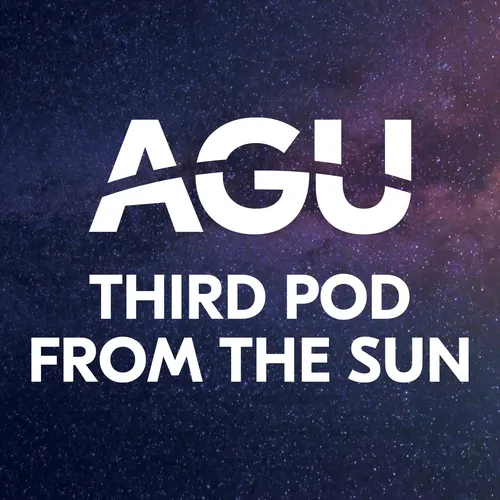
Third Pod from the Sun
Third Pod from the Sun is back, and we’re going weekly! We’re breaking things up into six-week mini-series and our first series is all about the true, personal stories from scientists, for everyone. Join us as we combat misconceptions about sharks, learn how to lasso lizards, hear from a Martian here on Earth, spark science joy via TikTok, journey to Antarctica, and fight over food with some capuchins!
- Update frequency
- every 6 days
- Average duration
- 25 minutes
- Episodes
- 189
- Years Active
- 2017 - 2023

Third Pod Presents: Sci & Tell - Jim Green on Space Exploration
We're trying something new with Third Pod. In addition to your regularly scheduled programming, we're going to showcase short stories from scientists in a new series we're dubbing Sci & Tell. Like sh…

Plate Tectonics: The Theory that Changed Earth Science
Xavier Le Pichon came to Lamont Geological Observatory in 1959 and spent four months aboard the R/V Vema as a physical oceanography technician. The research cruise set out to test the existence of th…

Special Release: Managing Emergencies in a Water World
Water is one of the things that none of us can live without. Yet, it’s taken for granted in so many parts of the parts, and even in parts of the U.S. But what would happen if we ever hit day ze…

Diamond Anvils and the Heart of Jupiter
Physicist Marius Millot investigates the intimate atomic worlds of elements in order to understand the inner secrets of the largest planets in our solar system. Jupiter and its fellow gas giants Uran…

Volcano Disaster Prepping
Many people have emergency kits packed to flee or survive forces of nature like floods, hurricanes, or wildfire. But what do you throw in your bag when you expect to rush toward a natural hazard? Geo…

Bonus Clip: Field Mishaps in Remote Chile
Check out this clip that didn't make it into our recent episode, X-rays of the Earth's Gooey Center, about some of the challenges Lara Wagner and her team face when setting up seismic stations …

X-rays of the Earth's Gooey Center
Much like x-rays can show broken bones (or noses), seismic equipment can show us what’s going on in Earth’s interior. While seismologists can’t take quick snapshots like medical doctors can, they can…

The Sun and the Exploding Sea
In 1972, in the waning years of the Vietnam War, U.S. military pilots flying south of Haiphong harbor in North Vietnam saw something unexpected. Without explanation, and without warning, over two doz…

Special Release: Deviations from the Norm
One of the most alluring parts of Earth and space science is that much of the key research takes place in the field, in some of the most incredible – and inhospitable – environments on the planet: on…

Ballooning on Venus
Venus, Earth’s nearest planetary neighbor, is a rocky world close in size to our own. In our solar system, it is the planet most like Earth. But Earth and Venus have taken different developmental pat…

Guardian of the Moon Rocks
Ryan Zeigler has a one-of-a-kind job: He’s the guy in charge of the Moon rocks.
Starting with Apollo 11 in 1969 and ending with Apollo 17 in 1972, astronauts brought back more than 800 pounds of samp…

Eavesdropping on the Ocean
To those of us on land, the world underneath the oceans seems quiet and serene. But scientists who study ocean acoustics will tell you it is anything but tranquil underwater. Our oceans are home to a…

Third Pod Live: Anthony Rapp of "Star Trek: Discovery"
At Third Pod, we often talk with researchers about how they grew up to become scientists. But how does an actor become a scientist on screen?
In this special episode of Third Pod from the Sun, we tal…

Night of the Killer Smog
The Clean Air Act of 1970 was one of the first and most influential environmental laws passed in the United States. But why was this law needed in the first place, and what inspired lawmakers t…

Riders on the Storm
Few natural phenomena are more difficult to study than tornadoes. They’re short-lived, their locations are notoriously hard to predict, and getting close enough to observe them is both challenging an…

A Tale of Two Journeys
In the early years of the 20th century, several groups of explorers attempted to be the first to reach the South Pole, as Antarctica was one of the last unexplored places on Earth. A team of Norwegia…

Bonus Clip: Memories of the North
In this bonus clip for our most recent episode, Science Turns to Search and Rescue, David Babb describes the incredible wildlife of the Arctic.

Science Turns to Search and Rescue
The Arctic Ocean is topped with a layer of frozen sea water – sea ice – that grows every winter and shrinks every summer. To study the ice in detail, researchers hop aboard an icebreaker ship that …

When the Sahara was Green
About 11,000 years ago, the Sahara desert turned green. The region received ten times the rain that falls there now, filling lakes and supporting savannahs, woodlands, and human communities. This wa…

Gunslingers of the Sea
Snapping shrimp are small but mighty creatures: they’re only a few inches long but are among the noisiest animals in the ocean. The loud cracking noise they make when snapping their claws sounds alm…